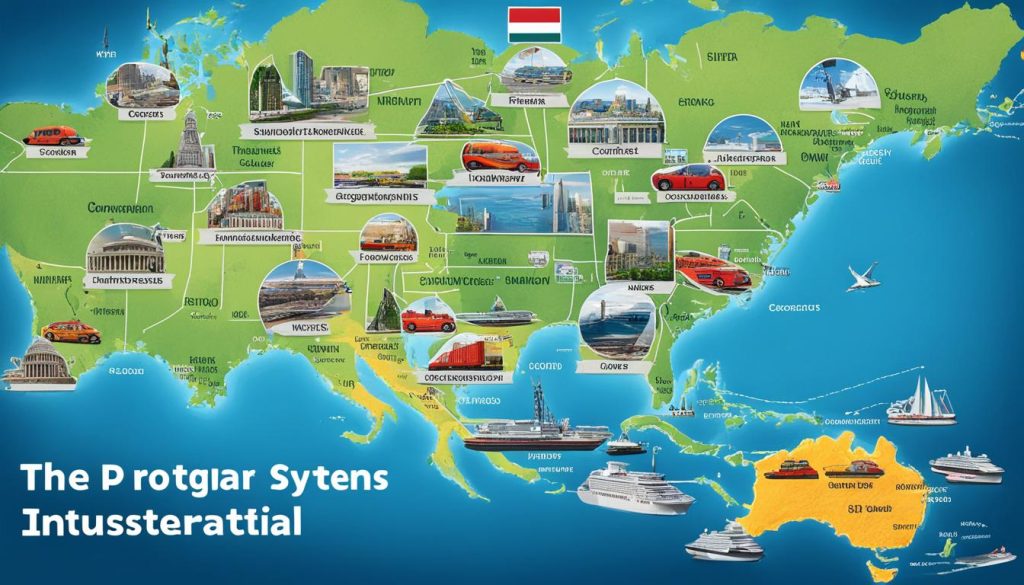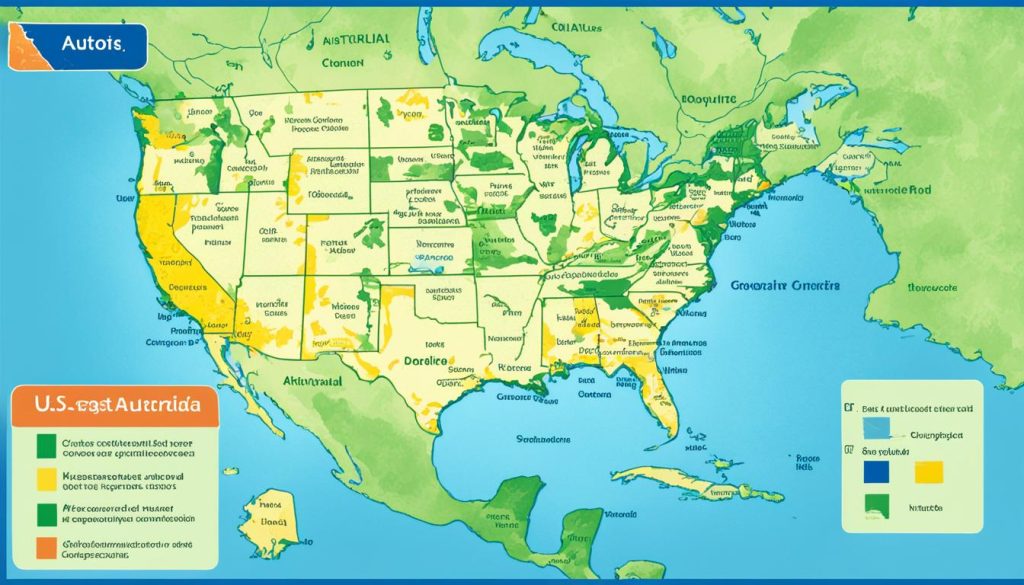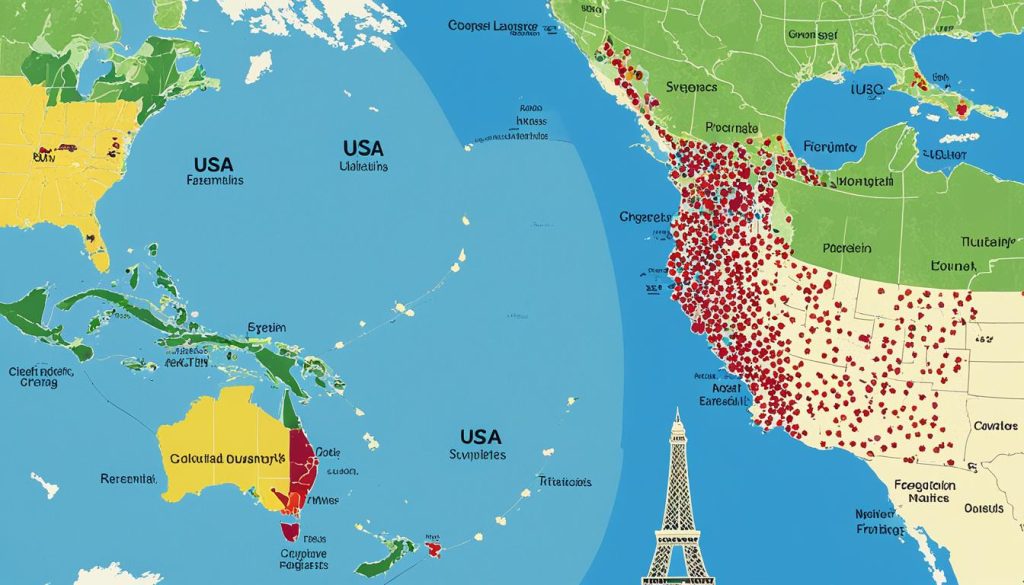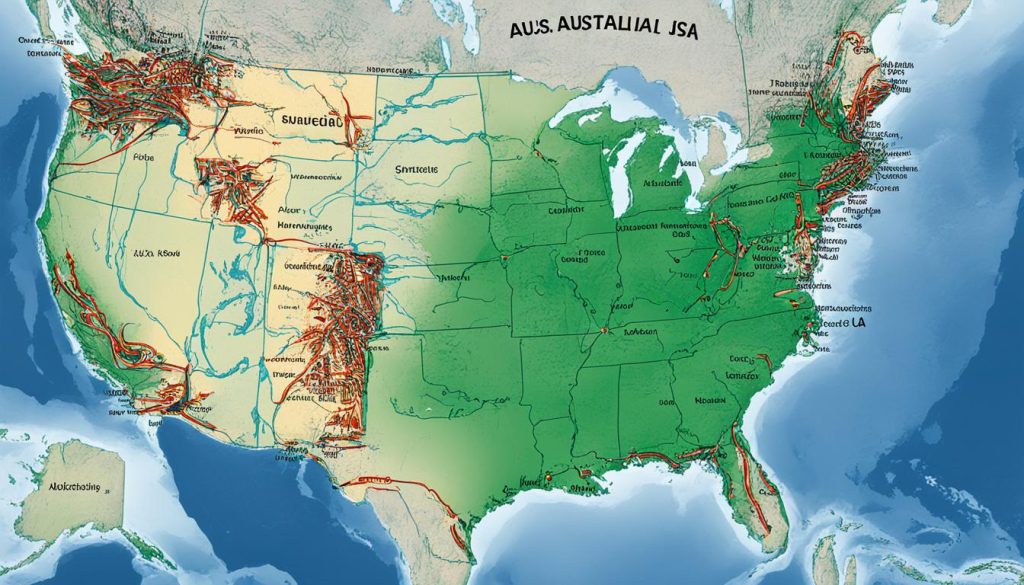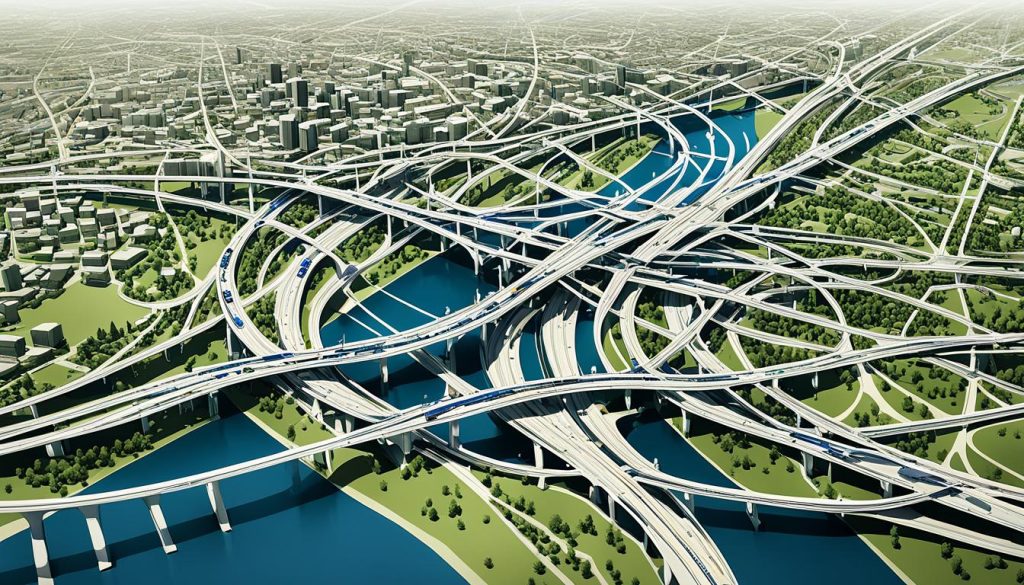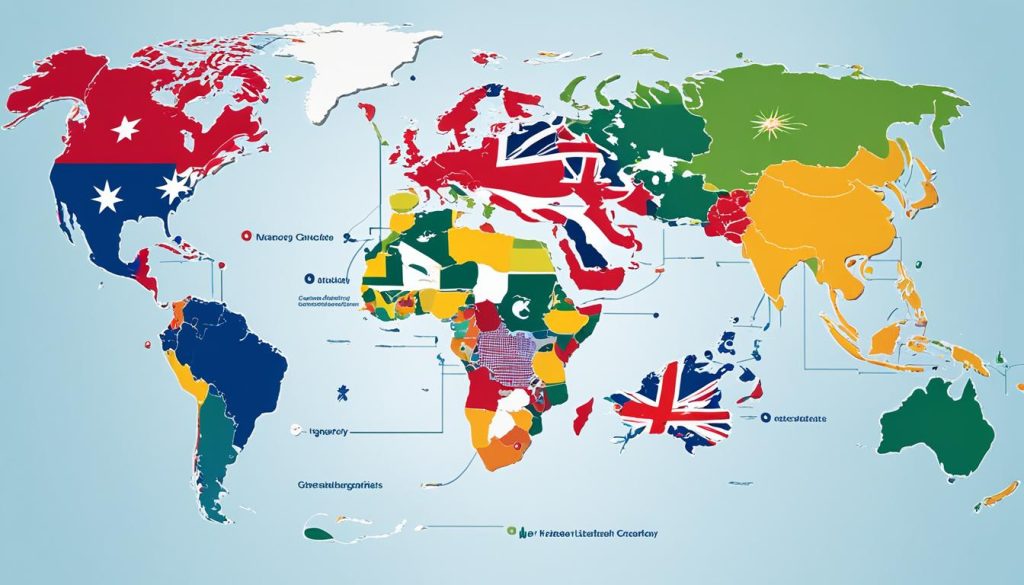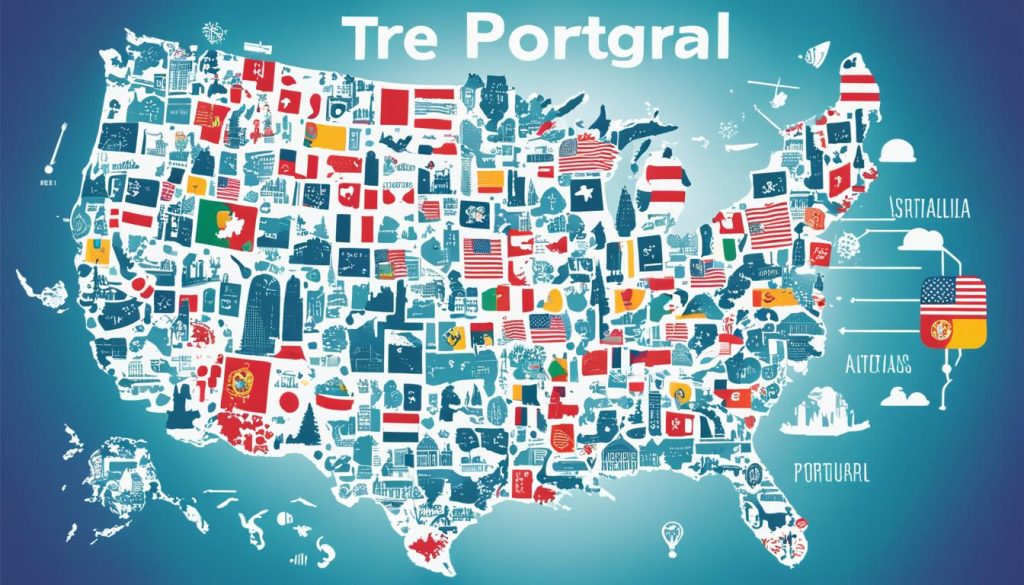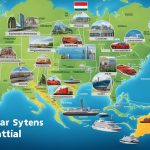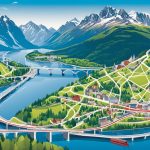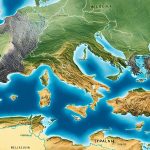This article looks at the geography and infrastructure of the USA, Australia, and Portugal. It shows how each country is different and what they have in common. This helps us understand their role in the world.
We carefully explore the size, strength of infrastructure, and effects on society of these countries. We find out how their landscapes and developed systems help them stand alone and together. This knowledge is key for anyone wanting to understand their power and connections.
A Geographical Overview of USA, Australia, and Portugal
Australia stands out with its vast land covering 7,741,220 km². This shows how varied its landscapes and life can be. Portugal, on the other hand, stretches over just 92,226 km². It’s smaller but also boasts varied weather patterns across different areas.
The USA is a giant when it comes to size, with a land that sees all sorts of weather and natural habitats. This mix of climates and landscapes makes every state and region quite unique.
- Portugal, nestled at Europe’s western frontier, experiences a temperate maritime climate. The north invites cool, rainy spells while the south enjoys a considerably warmer and drier ambiance.
- Australia’s vast land area statistics are complemented by pronounced climate variations—teeming deserts in the interior contrast sharply with the temperate conditions along its coasts.
- The USA offers a wide climatic spectrum from the tropical wetness experienced in Hawaii and Florida to the biting arctic conditions in Alaska, not to mention the arid plains of the Great Basin.
The vast differences in land and climate between these countries highlight how geography shapes a nation’s way of life, its economy, and its culture.
Landscapes and Climate: Contrasting USA, Australia, and Portugal
Exploring Earth’s ecosystems show how important climatic diversity is in the USA, Australia, and Portugal. These countries display a rich mix of weather patterns. They each bring a unique touch to our planet’s environmental mosaic and atmospheric wonders.
Temperature Variations and Climatic Patterns
See nature’s cleverness in the temperature fluctuations across these countries. The USA’s weather changes from Alaska’s cold to Florida’s warmth. Australia has very hot days, especially in its desert heart. In contrast, Portugal enjoys milder weather, from damp north to sunny south.
Landforms and Natural Beauty Across Three Nations
The striking landforms and natural wonders in these countries amaze everyone. Australia’s land is full of unique greenery and wildlife. Portugal’s forests, covering 37.8% of the country, are rich in stories and life. The USA’s vast landscapes include farms, mountains, and national parks that show the country’s beauty on a grand scale.
Navigating Through the Population and Demographics
Getting to know how populations change gives us big clues about a country’s social and economic life. When we look closely at how many people live in areas, how quickly towns and cities grow, and who lives there, we understand how communities change over time.
Population Density and Urban Spread
In the USA, Australia, and Portugal, the number of people and where they live varies greatly. The US has a mix of busy cities and wide-open spaces, with fewer people per square kilometre than Portugal. Portugal, on the other hand, has 112 people living in every square kilometre. Australia’s big, open lands mean very few people per square kilometre, showing the challenges of keeping everyone connected.
The different growth rates in these countries show us how their cities and towns are expanding. The USA and Australia are growing a bit, while Portugal’s population is getting smaller. This tells us about the changes and challenges each country faces.
Age Demographics and Life Expectancy
Looking at the ages of people in these countries shows big differences too. Australia’s people are quite young on average, living into their mid-eighties. Portugal, however, has an older average age of 46 years and a slightly shorter life expectancy for men and women.
The US has a life expectancy similar to other developed countries but has its own set of challenges. It has to look after a wide variety of people spread out across a large area. These age trends help us think about what each country needs to do for its people’s health and well-being.
Comparing the Economies: A Tri-nation Analysis
The health of a nation’s economy is often measured by its economic success. Key indicators like GDP per capita and gross national income are crucial. They not only show a country’s economic state but also compare it to others. To understand the economies of the USA, Australia, and Portugal, we need a detailed look at each factor, from workforce to inflation.
GDP and National Income: A Relative Study
GDP per capita is vital in economic analysis. It shows the economic output per person. The USA has a strong GDP per capita of $49,965.27, showing its global economic power. Australia’s economy is also booming, with a GDP of $52,191.00. Portugal’s GDP of $33,700.00 shows growth and resilience. Looking at gross national income, Portugal’s $270,087 M US$ stands out against Australia’s $1,582,214 M US$. These numbers are key for understanding each country’s place in the global economy.
Employment and Labour Statistics: A Cross Country Comparison
The health of an economy also comes from its employment rates. These rates vary widely across these countries. Australia boasts a low unemployment rate of 3.7%, indicating strong economic health. Portugal’s rate is higher at 5.8% but still noteworthy within Europe. The USA’s unemployment rates change, reflecting its large and diverse job sector. Analysing these economies also means looking at inflation, which affects buying power, workforce, and living standards.
- GDP per capita: Reflects economic output and living standards
- Gross national income: Indicates the total economic activity and international economic positioning
- Unemployment rates: Offers insights into the labour market health and employment opportunities
- Inflation statistics: Vital for understanding the cost of living and economic stability
- Workforce composition: Reveals the structure and adaptability of the labour force
In the end, these economic indicators weave a complex picture of the USA’s, Australia’s, and Portugal’s economies. This data helps us grasp the diverse economic strengths and challenges of each country.
Infrastructure Development: USA, Australia, and Portugal
Infrastructure investment and improvements in public works are key to progress. The USA, Australia, and Portugal show how different countries invest in their future. Let’s look at their approaches and what that says about their progress.
In the USA, you’ll find a vast network of highways, bridges, and public transport. This shows a big commitment to building a better country. Different states have different needs, leading to a variety of public works.
Australia focuses on smart development because of its recent economic growth. It invests in infrastructure to keep growing and tackle the challenges of its vast land and spread-out people.
Portugal, known for its history, is updating its old infrastructure. It wants to make its cities and countryside better by blending the old with the new.
- The USA’s big infrastructure spending keeps it strong globally.
- Australia uses its strong economy to support big infrastructure projects.
- Portugal upgrades its public works to mix tradition with modernity.
Each country has its way of investing in infrastructure. This reflects their situation and plans for the future. By looking at their strategies, we learn about their goals and challenges.
Transport Networks: A Deep Dive into Roads, Railways, and Air Travel
Road networks, train systems, and aviation infrastructure mark the strength of a country’s global links. Each country employs its special geography to build essential transport routes. These include highways critical for moving people and goods smoothly.
Extensiveness of Road Infrastructures
In Australia, roads stretch over 873,573 kilometres, showing a nation’s effort to link its vast territories. In contrast, Portugal’s network spans 11,217 kilometres of roads. This network fits its smaller size but connects well with Europe.
The USA’s large highways reflect its wide area and economic power. They create a network connecting cities and regions across the continent.
Comparison of Rail Networks
The USA and Australia have rail networks of 32,606 kilometres and 3,622 kilometres, respectively. Trains play a key role in their economies and mobility. Despite its smaller size, Portugal’s rail system is efficient. It covers 0.35 kilometres per 1000 inhabitants, integrating well into its transport plans.
Airport Facilities and Accessibility
Air travel is vital for global and local connectivity. The USA, with its many airports, is a major airport hub. Australia’s 281 airports help connect different parts of the country. Portugal may have 23 airports, but it’s crucial in Europe. It offers many flights that boost its tourism.
Roads, rails, and air travel together improve transport networks in these countries. This shows the ongoing growth of transit systems. It highlights how important transport is for a country’s global standing.
Analysis of Energy Production and Consumption
The USA, Australia, and Portugal are tackling the challenge of meeting energy needs while protecting the environment. They adopt unique methods and invest in green technology based on their own situations. Their efforts aim to cut down CO2 emissions, considering their geographical and economic situations.
Renewable Energy Capacity and Sustainable Practices
All three countries aim to develop sustainable energy. Portugal is investing in wind and hydro power, moving towards a greener grid. Due to its sunny climate, Australia is making big strides in solar energy, using its natural advantage.
The USA is working on reducing its huge energy use by embracing green technology. Through big projects and partnerships, it’s heading towards cleaner energy. This reduces environmental harm usually linked with making electricity.
Energy Usage Patterns
These countries have different ways of using energy, affected by their industries, populations, and environmental goals. The USA and Australia have high electricity use, matching their big industrial activities. Portugal shows a balanced use of energy, managing well despite its smaller size.
These nations are not just changing where their energy comes from. They are also focusing on using energy more efficiently and sustainably. They are cutting CO2 emissions by adapting to change and moving towards renewable energy.
Education and Health: Foundations of Societal Well-being
The strength of a society is often seen in its education and health care. Good education and health care show a nation’s well-being and economic health. Looking at these areas helps us understand what different countries focus on.
Education Systems and Expenditure on Learning
Putting money into education helps grow a smart workforce. This workforce drives new ideas and economic strength. Australia spends a lot of its budget on education, leading by example. Portugal, though investing well, does not reach Australia’s level by 8.16%. The USA shines in higher education but is working on making education equal for all.
Healthcare Accessibility and Quality
Having access to good health care is vital for a country’s well-being. Australia provides plenty of hospital beds for its people, showing its commitment to health care. Portugal also has a strong health system with a good number of hospital beds. In the USA, there’s a mix of private and public health care, showing a high standard of health care through its number of doctors.
Digital Connectivity: Comparing Telecommunication Networks
Exploring the world of telecommunication shows how crucial digital connections are today. Countries around the world are improving their digital networks. This ensures that everyone can join in the growing digital world. When looking at the digital structures powering our societies, we see how essential internet and mobile networks are. They show us how far technology has come and how it improves our lives.
Internet Penetration and Broadband Speeds
In the UK, there’s a big focus on getting fast internet to everyone. This goal is shared by countries like Australia, Portugal, and the USA. They’re all working hard to close the digital gap. They’re doing it by investing in better broadband, which makes the internet faster and more reliable everywhere. These efforts mark a move towards a world that’s more connected than ever before.
Mobile Network Coverage and Usage
Mobile phones and networks are spreading fast, changing how countries operate. In places like Australia and Portugal, almost everyone has a mobile phone. The USA, with its huge land area, needs a big network to reach everyone. Mobile networks are key, whether in crowded cities or remote areas.
With technology advancing quickly, telecom services are central to how societies and economies work. As digital networks grow and improve, we can expect life to get better everywhere. This will make these countries more competitive globally.
Assessing Quality of Life: Indices and Public Services
People everywhere strive to improve their living standards. They look at public services to see how they affect quality of life. The United States, Australia, and Portugal try to make daily life better for their people.
- In Australia, public sector services like healthcare and education are top-notch. They show Australia’s dedication to its people’s wellbeing. Thanks to a favourable climate, Australians enjoy many outdoor activities. This boosts their health and happiness.
- Portugal offers an affordable way of life, making it attractive for young families and the elderly. Its lower cost of living doesn’t compromise on living standards.
- The USA’s quality of life rankings vary widely. It’s a mix of innovation and available services against a backdrop of unequal access. This shows the different conditions across its large area.
Quality of life is linked to political stability and the environment. But it’s the real-life experiences that count. Services need to be accessible, reliable, and for everyone. By looking at these factors, we can understand a society’s quality of life.
Trade and Commerce: Evaluating the Business Environment
An economy’s strength is often measured by looking at its business climate, trade amount, and how active it is economically. The huge Gross Domestic Product of the United States shows it’s a lively place for trade and industry. Meanwhile, Australia, with its strong export numbers, shows that smaller economies can still have a big impact on world trade volumes.
Portugal may be smaller, but it keeps up important trade links essential for its economy. Each country shapes its business scene with tax policies and government help. This shows different ways to boost a business-friendly space and control the market.
- United States’ Economy: A reflection on the dynamic and expansive nature of American economic activities.
- Australian Trade: An insight into the considerable trade volumes stemming from Australian shores.
- Portugal’s Commercial Landscape: Understanding Portugal’s strategic economic engagements within its scaled trade volumes.
Different levels of trade and complex economic policies offer a rich area for comparison. This helps us see how countries manage international trade and grow their businesses at home. The business climate and trade numbers of each nation reveal the diverse nature of the global economy.
Environmental Sustainability: Practices and Policies
Nations around the world now understand how important it is to protect the environment. They see the bad effects our actions can have on nature. So, there is a big push to look after our habitats better. These efforts are key to making our planet healthier. They also aim to cut down on CO2 emissions, meeting global standards.
Conservation Efforts and Forest Coverage
Keeping our environment safe is key to sustainable development. Take Portugal as an example. It has a lot of forests which help protect the environment. This shows how serious Portugal is about saving nature. On the other hand, Australia uses its big farming lands to help nature. It strikes a balance between farming and keeping ecosystems healthy.
- Protecting endangered species through conservation programmes.
- Promoting the expansion and maintenance of protected green areas.
- Implementing rigorous habitat conservation strategies to maintain biodiversity.
Carbon Footprint and Emission Standards
Fighting climate change brings a spotlight on cutting CO2. There are now rules to lessen the harm from our industries and homes. Australia works hard to use sustainable energy. This is because it wants to reduce its carbon emissions. Portugal is doing well in cutting its emissions, showing its commitment to a cleaner environment. However, the USA’s high emissions point out a big need for stricter rules.
- Strengthening emissions policies to achieve significant CO2 reduction.
- Adopting renewable energy sources to lessen environmental impact.
- Engaging the international community in setting and reaching emissions targets.
Socio-cultural Fabric: Language, Religion, and Ethnic Diversity
The cultural mix of any nation is like a tapestry. It’s made of language, religion, and where people come from. To really understand a country’s rich variety, we must look at these parts.
Looking at the languages people speak, and official languages reveals how we connect. Religions show the spiritual and moral values of a society. And, the mix of ethnic groups and people moving from place to place makes cultures vibrant and diverse.
Linguistic Landscape
In the world of global chat, the USA and Australia stand out. They speak many languages besides English, their main language. This shows how diverse and dynamic they are, full of cultural exchange.
In contrast, Portugal mostly speaks Portuguese. This gives it a special cultural identity linked to its language.
Religious Affiliations and Practices
Spirituality comes in many forms. In Australia, 62.1% are Christians. Portugal has a strong Christian community too, with 84.3%.
The USA, however, shows off its rich mix with many different religions. This religious mix shapes social life and culture in each country.
Ethnic Composition and Multiculturalism
The USA mirrors a vast range of cultures, truly multicultural thanks to its diverse people and migrants. This mix defines the American spirit, known for its diversity.
Australia and Portugal might be less diverse, but they still have their own multicultural spots. This mix shows a miniature world, where different stories and people live together.
Compare geography and infrastructure between USA, Australia and Portugal
Comparing the USA, Australia, and Portugal reveals big differences and some similarities in their landscapes and how they build their communities. This part of our article combines all the details from a deep geographic analysis. It looks at how a country’s size and shape really affects its people and the buildings around them.
Different landscapes mean different needs for roads and buildings. We looked at how the big sizes of the USA and Australia need different approaches compared to Portugal’s smaller, but still varied, areas.
Our study shows the clever ways each country deals with its natural spaces and challenges, using their geography to their benefit and tackling problems unique to their location. Here’s a peek at how each nation’s geography and building efforts come together:
- Land and Climatic Diversity: From dry Australian lands to green spots in Portugal and the varied climates of the USA, each place has its own landscape. This shapes what they invest in and build.
- Population Density and Distribution: Australia’s few people spread out means they plan differently than Portugal, where lots of people live close together. The USA has to think about both crowded cities and quiet rural areas.
- Transportation Networks: In the USA, large networks help with trade and moving around. Australia focuses on key routes to link wide spaces. Portugal uses efficient systems for its small size.
- Energy Sources and Sustainability: Portugal is working on green energy, while Australia and the USA are also trying to use more renewable sources in their big energy plans.
Each country’s geography and how they build things show their unique traits. By looking closely at their infrastructural evaluation, we see how smart designs adjust to nature. This careful planning of land and efforts shapes each country’s global role.
Conclusion
This study closely looks at the USA, Australia, and Portugal. We see how their geography and infrastructure mix to shape their growth. Each country’s size, resources, and people work with tech advancements to pave their way forward. Decision-makers use these factors to unlock their country’s strength, tackle issues, and grab chances.
The landscape across these nations varies greatly. The USA has diverse ecosystems and climates. Australia’s vast territory and Portugal’s unique terrain both present benefits and hurdles. Their infrastructure growth is linked to this variety. Innovation and eco-friendly methods are central to their future plans in transport, energy, and more.
Examining these countries helps us understand and value the role of geography and infrastructure. They support economic health, cultural richness, and quality of life. As the USA, Australia, and Portugal grow, their geography and built environments are key to their stories of advancement and toughness.

